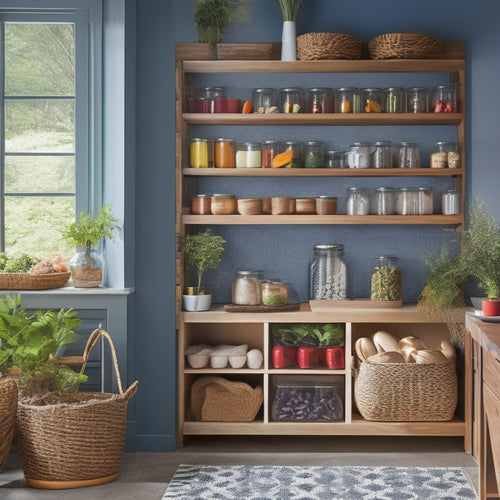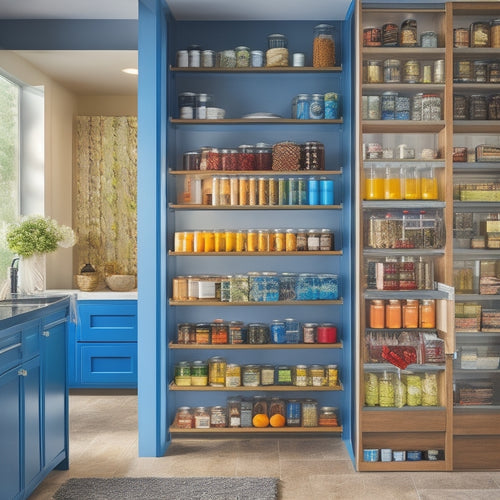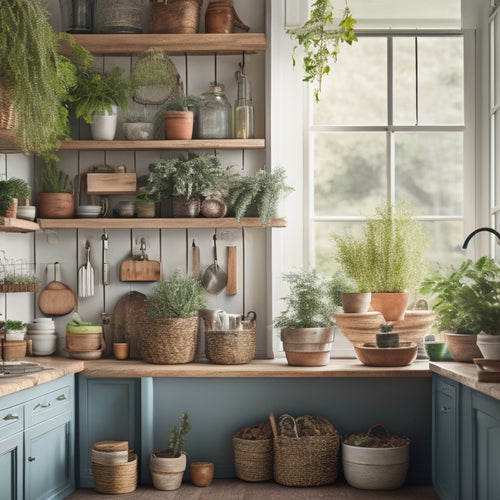
Why Busy Families Need a Clutter-Free Kitchen
Share
You need a clutter-free kitchen because it's the difference between a chaotic morning routine and a calm, organized start to your family's day. When your kitchen is cluttered, meal prep and cooking take longer, causing stress and increasing the likelihood of last-minute takeout orders. A clean space, on the other hand, helps you establish daily habits, optimize your kitchen layout, and prioritize essential items. By implementing these strategies, you'll create a peaceful cooking experience, teach your kids valuable skills, and maintain a clutter-free kitchen that functions smoothly. Now, discover the specific practices that can transform your kitchen and your mornings.
Key Takeaways
• A clutter-free kitchen helps busy families save time and energy by reducing stress and increasing meal prep and cooking efficiency.
• Cluttered kitchens can lead to last-minute takeout orders, but a tidy space promotes healthy meal planning and cooking habits.
• A well-organized kitchen layout allows family members to work together efficiently, teaching kids essential life skills like teamwork and time management.
• By assigning a home for everything, busy families can maintain a peaceful cooking environment, reduce visual clutter, and focus on serving healthy meals.
• A clutter-free kitchen helps families develop good habits, such as cleaning as they go, and instills a sense of ownership and accountability in kids.
Simplify Meal Prep and Cooking
By streamlining your meal prep and cooking routine, you can shave off up to 30 minutes of daily kitchen time, freeing you up to focus on more vital things.
One key strategy is to implement a meal planning system that works for you. This can be as simple as planning out your meals for the week on Sundays, making a grocery list, and sticking to it. By doing so, you'll avoid last-minute takeout orders and reduce food waste.
Effective time management is also essential in simplifying meal prep and cooking. Try batching similar tasks, such as chopping vegetables or cooking proteins, to maximize your efficiency. You can also prep ingredients in advance, like cooking rice or roasting vegetables, to make meal assembly a breeze.
Reduce Stress With a Clean Space
A clutter-free kitchen is your secret weapon against stress, and maintaining it starts with creating a daily habit of tidying up as you cook. By doing so, you'll avoid the overwhelming feeling of walking into a messy kitchen, which can instantly increase your stress levels.
Imagine having a peaceful cooking experience, where you can focus on preparing a delicious meal for your loved ones.
To reduce stress with a clean space, follow these simple tips:
-
Organize your pantry: Assign a home for each item, and group similar products together. This will save you time searching for ingredients and prevent clutter from building up.
-
Declutter countertops: Clear off countertops by storing appliances and gadgets in designated areas. This will create a sense of openness and make cleaning easier.
-
Implement a 'one in, one out' policy to prevent clutter from accumulating in the future.
- Set aside 10 minutes each day to tidy up and maintain your kitchen's cleanliness.
Create a Functional Kitchen Layout
You've set the stage for a stress-reducing kitchen by establishing daily habits and purging clutter, now it's time to optimize your kitchen's layout to maximize efficiency and functionality.
A well-planned kitchen organization system guarantees that everything has its designated place, making meal prep and cooking a breeze. Start by identifying your kitchen's workflow - where do you prep, cook, and clean? This will help you determine the most efficient layout for your space.
Consider the 'golden triangle' concept, where your sink, stove, and refrigerator form the points of a triangle. This layout minimizes walking distances and maximizes efficient storage. Ensure that your most frequently used items are easily accessible, and less frequently used items are stored out of the way.
Efficient storage solutions, such as pull-out cabinets and drawer dividers, can help keep your kitchen organized and clutter-free. By streamlining your kitchen layout, you'll be able to cook and serve meals with ease, making mealtime a more enjoyable experience for your family.
Designate a Home for Everything
Assigning a designated spot for each item in your kitchen guarantees that everything has a place to return to, making it easier to maintain order and find what you need when you need it. This is especially important for busy families, where every minute counts. By designating a home for everything, you'll save time searching for misplaced items and reduce stress in the process.
To get started, consider the following organization tips:
-
Utilize vertical storage solutions: Install shelves, hooks, or a pegboard to maximize your kitchen's vertical space and keep frequently used items within easy reach.
-
Implement a labeling system: Label each designated spot, so everyone in the household knows where items belong.
-
Assign a spot for daily essentials: Designate a specific spot for daily essentials like coffee mugs, water bottles, or lunch boxes to keep clutter at bay.
- Create a 'junk drawer': Designate a single drawer for items that don't have a designated home, like batteries, twist ties, or takeout menus, to prevent clutter from spreading throughout the kitchen.
Prioritize Essential Kitchen Items
Streamlining your kitchen essentials helps you focus on the must-haves, freeing up space and reducing clutter. By prioritizing what you truly need, you'll create a more efficient kitchen that serves your busy family.
Take stock of your kitchen items and categorize them into three groups: essentials, nice-to-haves, and unnecessary items. Be honest with yourself – do you really need that bread maker or the fancy coffee machine?
Adopt a minimalist approach by keeping only the items that bring you joy or serve a practical purpose. This will help you avoid clutter and make the most of your kitchen space.
Consider investing in efficient storage solutions, such as stackable containers or a utensil organizer, to keep your essentials within easy reach. By paring down your kitchen items, you'll reduce visual clutter and make meal prep a breeze.
With a clutter-free kitchen, you'll be able to focus on what matters most – serving healthy, delicious meals to your loved ones.
Banish Kitchen Clutter for Good
To banish kitchen clutter for good, start by scheduling regular decluttering sessions, ideally during a less chaotic time of day, like early morning or right after dinner. This will give you a fresh perspective and help you tackle the task with more energy.
Here are some organizing tips to get you started:
-
Purge unnecessary items: Be ruthless – if you haven't used it in the past year, it's probably safe to get rid of it.
-
Designate a home for each item: Assign a specific spot for each kitchen tool, gadget, or appliance to keep them from cluttering your countertops.
-
Utilize storage solutions: Invest in cabinets, drawers, and shelves that maximize your kitchen's storage capacity.
- Implement the 'one in, one out' rule: For every new item you bring into your kitchen, get rid of an old one to maintain a balanced level of possessions.
Streamline Kitchen Workflow Efficiency
By rethinking your kitchen layout and workflow, you can shave precious minutes off meal prep and cooking times, making it easier to get healthy meals on the table even on the busiest of days.
One time-saving tip is to designate specific zones for different tasks, such as a prep zone with a cutting board and utensils, and a cooking zone with pots and pans. This organizational hack streamlines your workflow and reduces clutter.
Implement family-friendly solutions like a 'launching pad' near the fridge or a designated spot for meal planning and grocery lists. This helps keep everyone on the same page and guarantees that meal planning strategies are executed efficiently.
Consider a 'first in, first out' system for your pantry and fridge to reduce food waste and save time searching for ingredients.
Establish a Morning Routine
You start your day in the kitchen, and a well-planned morning routine can set the tone for a clutter-free and efficient day. By establishing a consistent morning routine, you'll be able to tackle the day with confidence and energy.
Here are a few tips to get you started:
-
Plan your meals: Take a few minutes each morning to review your meal plan for the day. This will help you prep ingredients, pack lunches, and avoid last-minute takeout runs.
-
Prioritize tasks: Make a quick to-do list of tasks that need to be completed in the morning, such as packing backpacks or prepping breakfast. Focus on the most important tasks first, and delegate others to family members if possible.
-
Set a timer: Give yourself a set amount of time to complete your morning routine. This will help you stay on track and avoid procrastination.
- Leave some buffer time: Build in some extra time to your morning routine for unexpected tasks or setbacks. This will help reduce stress and make your morning feel more manageable.
Teach Kids Kitchen Responsibility
How can empowering your kids to take on kitchen responsibilities benefit your entire family and contribute to a clutter-free kitchen?
By teaching your kids kitchen responsibility, you're not only raising independent individuals but also creating a sense of ownership and accountability. This, in turn, helps maintain kitchen organization and reduces clutter.
Assign age-appropriate tasks, such as loading the dishwasher, wiping down counters, or setting the table, to encourage child involvement. As they take on these responsibilities, they'll develop essential life skills, like time management and teamwork.
Additionally, involving your kids in kitchen tasks helps them understand the importance of cleanliness and order, instilling good habits that will benefit them throughout their lives.
By delegating tasks, you're also freeing up time for yourself to focus on other aspects of your busy life.
Maintain a Clutter-Free Kitchen
To maintain a clutter-free kitchen, designate a specific place for everything, ensuring that each item has a designated home where it can be easily found and put away. This simple habit will save you time and energy in the long run. By implementing these organization tips, you'll create a more efficient kitchen that functions smoothly, even on busy days.
Here are some additional time-saving hacks to help you maintain a clutter-free kitchen:
-
Clean as you go: Wipe down countertops, sink, and stove after each meal to prevent crumbs and spills from building up.
-
Use vertical storage: Install shelves, hooks, or a pegboard to maximize storage space and keep frequently used items within easy reach.
-
Schedule regular decluttering sessions: Set aside 10-15 minutes each week to tidy up and get rid of any unnecessary items.
- Implement a 'one in, one out' policy: For every new kitchen item you bring in, get rid of an old one to maintain a balanced amount of possessions.
Frequently Asked Questions
How Do I Keep Clutter From Coming Back After Organizing?
'You've finally tamed the clutter beast, but now you're wondering how to keep it from coming back. Implement storage solutions, practice maintenance tips, and adopt preventive measures like organizing habits to guarantee your newly organized space stays serene and functional.'
What if My Family Members Resist the New Clutter-Free System?
When family members resist your new clutter-free system, don't give up! Identify the root of their resistance and communicate openly, finding compromises that work for everyone, to maintain a harmonious family dynamic.
Can a Clutter-Free Kitchen Really Save Me Time and Money?
You're stuck in a cycle of chaos, but a clutter-free kitchen can be a game-changer, saving you time through efficient organization and money by reducing food waste, allowing you to focus on what truly matters.
How Do I Handle Paper Clutter Like Receipts and Coupons?
You tackle paper clutter by designating a spot for organizing receipts and sorting coupons, then set aside time each week to maintain your system, ensuring you stay on top of paperwork and maximize savings.
What Are Some Creative Ways to Repurpose Old Kitchen Items?
As you rummage through your kitchen, imagine a treasure trove of hidden gems waiting to be upcycled. You'll uncover innovative storage solutions by repurposing old items into DIY organization tools and kitchen gadgets, breathing new life into your cooking space.
Related Posts
-

Sliding Pantry Storage Ideas for Renters
If you're looking to optimize your rental kitchen, sliding pantry storage solutions could be your answer. Employ vert...
-

Sliding Pantry Organizers With Tiered Racks
Sliding pantry organizers with tiered racks optimize your pantry space and enhance accessibility. These organizers cr...
-

Countertop Storage Ideas for Small Kitchens
If you're looking to maximize your small kitchen, creative countertop storage solutions can make a big difference. Em...


